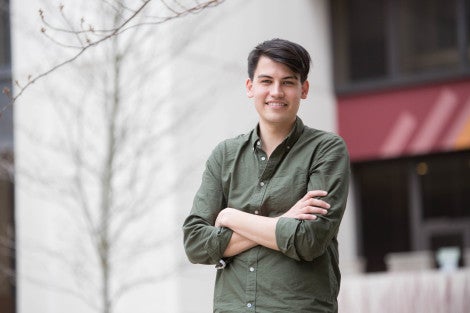May 1, 2015 — Steven Hafner is constantly asking the question “why?” And at Harvard T.H. Chan School of Public Health he’s directing that question to the issue of violence against Native American women.
“They experience high, high rates of violence, whether that is intimate partner abuse involving a spouse or significant other, domestic assaults involving families or children, or sexual assaults,” said Hafner, who is of Oglala Sioux descent and a second-year doctoral student in the Department of Social and Behavioral Sciences. The statistics are staggering: A recent Justice Department report estimated that one in three Native American women will be raped in their lifetime. “We’re trying to figure out what’s leading to those higher levels and finding out not only what can be done to help the victims, but also what can be done to stop the perpetrators, or would-be perpetrators.”
Hafner believes the best way to do that is through communication through multiple channels, ranging from social media mass marketing to one-on-one counseling. A key focus for Hafner is ensuring that people have access to—and are aware of—resources that can help them. That could mean posting a phone number on a website, visiting schools to meet with students, or even reaching out to policymakers to ensure that resources are funded.
At Harvard Chan, Hafner marries this passion for communication with the study of social determinants—looking at a broad array of environmental factors that can affect a person’s health and essentially asking, “why?”
“Why does someone decide to be violent? I think there are a number of factors that go into that—that makes someone see violence as an option and something that’s acceptable or as a way of solving a certain problem,” said Hafner.
The power of communication
Hafner’s own environment shaped his path to public health—one that he calls a “gradual process.” He’s a native of Custer, South Dakota, a town of about 2,000 in the rural Black Hills near the Wyoming border. While in college, Hafner spent his summers working as a naturalist and educator for the South Dakota Department of Game, Fish, and Parks, which is where he developed a passion for communication—especially at a one-on-one level.
Combining an interest in communications and health care, he received a master’s in health education at Columbia University and eventually entered the doctoral program at Harvard Chan.
The act of communication is ingrained in our everyday lives, said Hafner. “It’s verbal, it’s nonverbal, it’s printed, we hear it. It’s something that’s so pervasive, and if you can understand how to effectively use it, it can be a super powerful tool.”
Faculty mentors
Violence is a complicated issue, and Hafner says that his approach to it is strengthened by the holistic education he receives at the School.
He’s working with his advisor, and an expert in the field, K. “Vish” Viswanath, and has also benefited from with the courses he’s taken with faculty members Cassandra Okechukwu and Nancy Krieger.
“If I’m going to make a [communication] campaign then I’m going to need some theory to tell me how to create that message,” Hafner said, citing one of the takeaways from his classes with Okechukwu, who studies the impact of environmental factors on health. “What am I trying to change in people’s thinking; their perceptions, their attitudes? What is it that we’re going to look at and measure to see if we’ve changed it?”
Hafner says Krieger helps him learn to ask those critical “why” questions.
“Instead of looking at how people get illnesses, or come down with certain conditions, it’s looking at [what are the] population patterns of those outcomes,” said Hafner. Statistics can tell Hafner that Native American women experience higher rates of violence than other women, but in order to develop an effective intervention he needs to understand why they’re more vulnerable.
Constructive emotions
Hafner has seen firsthand the impact communication can have through a stint working at the State Treatment and Rehabilitation (STAR) Academy, a juvenile correction facility in Custer. He noticed that youths would enter the program and perform well, but then struggle after heading back to their home environments. Many ended up returning to the facility.
Hafner couldn’t monitor the youths when they went home, so he focused on teaching them how to understand and communicate their emotions and feelings in more constructive ways. “A lot of youths, they have an emotion and they automatically assume it’s anger and they react in an angry way,” he said.
Hafner also worked with youths before the kids returned home and discussed their relationships with parents and relatives. He emphasized the importance of leaning on family members for support, saying that they could play a key role in helping them turn around their lives.
“I think it’s a fantastic age at which to intervene because things that are happening at that age are going to affect them throughout the course of their life. If you can have a positive impact at that point, you can really change someone’s trajectory for the rest of their life.”
photo: Emily Cuccarese
